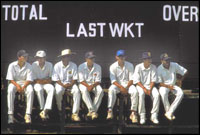 January 17, 2002
January 17, 2002
The test starts from school
- Jonathan Dyson
The batsman, on 99, gently strokes the ball into the covers for comfortable single, jogs to the non-striker's end, and immediately waves his bat to acknowledge the hearty applause of his team-mates and the crowd, and doffs his cap with obvious pride.
No, I am not reliving Craig White's series-turning hundred in Ahmedabad, nor am I fantasising, as every cricket fan does on occasion, about scoring a century at Lord's. In fact, I am recounting a scene from a Giles Shield school match at Shivaji Park, Mumbai, on Tuesday.
The centurion was fourteen-year-old Sarvesh Damle, and the match was the semi-final between his own IES VN Sule Guruji English Medium School, batting first in a two-day game, against IES New English School.
Of all the types of cricket I have seen in India, from street cricket through to Test matches, it is perhaps the school games I have seen in Mumbai over the last few days that have fascinated me the most. I had heard before arriving in Mumbai about the strength of its schools cricket, but had never quite realised the extent of its long and proud history, its fierce intensity or its outstandingly high standard.
 Never, that is, until I was browsing through the
Marine Sports bookshop in Dadar, when I picked up a
volume entitled Lord Harris Shield Cricket Tournament
Commemoration Volume - 1897-1997.
Never, that is, until I was browsing through the
Marine Sports bookshop in Dadar, when I picked up a
volume entitled Lord Harris Shield Cricket Tournament
Commemoration Volume - 1897-1997.
Published in 1997, the book celebrates the first hundred years of the Harris Shield by telling the story of the competition, from its establishment in recognition of the fourth Lord Harris's contribution to Bombay cricket, through the world record stand for any wicket in any class of cricket by Vinod Kambli and Sachin Tendulkar in 1988, to the present day as the tournament continues to flourish.
One of the main themes of the book is how the Harris Shield has provided an extraordinarily thorough grounding for future Test players, in the process giving berths to among others Vijay Merchant, Vijay Manjrekar, Sunil Gavaskar, Dilip Vengsarkar, Ravi Shastri and of course Kambli and Tendulkar.
The reason this is of such interest to me is that I had always wondered how India's selectors could thrust a young player into Test cricket at a young age, even as a teenager, and then see that player look comfortable right from his first Test.
As I noted after the end of the Test series, players like James Foster and Richard Dawson, who came into Test cricket after minimal first-class experience and yet looked competent in the series, are so much more rare in England.
I was hoping to see the first day of the Harris Shield Final on Tuesday, but unfortunately this had been postponed due to a protest lodged by IES VN Sule Guruji School against Rizvi Springfield High School, due to a suspicion that Springfield had played five over-aged boys in their semi-final encounter, which Springfield won by 253 runs.
Instead, I watched the first Giles Shield semi-final in which Damle scored his memorable hundred. Yet even at under-14 level I could see why the schools cricket in Mumbai helps prepare players for Test cricket so effectively.
For a start, from the quarter-finals onwards, games are played over two days, and the final four days. This allows a batsman to build an innings, using a sound defensive technique as a platform, patiently waiting for a poor delivery, and batting all day if he can, while the bowlers, with no limitation on the number of overs they can bowl, wile away, persistently probing away at a batsman's weakness.
This in turn leads to a highly intense form of cricket. Damle, for instance, was on 99 for ten balls in a tense and compelling passage of play when the bowlers were clearly hell bent on stopping him reach his hundred. For a while it was reminiscent of Kumble's brilliant over against Trescothick in the Ahmedabad Test, when the leg-spinner used all his experience and variety of delivery to make the left-hander sweat over getting to the landmark. That time, of course, Kumble got his man, but on this occasion, Damle passed the test of nerve impressively.
It is this kind of "man's" cricket, combined with the subsequent unending ebb and flow of each day's play, that clearly help Mumbai school players prepare for the Test arena. And it is here where England's system is found lacking in comparison. Due to a far more crowded and regimented curriculum, it is virtually impossible to find time in English schools to play a match over more than one day.
In fact when I played schools cricket in Yorkshire, which wasn't that long ago (I finished in 1997), we were lucky to play a game as long as 40 overs per side, never mind over more than one day. And my school was one of the outstanding schools for cricket in the area.
To further my understanding of Mumbai schools cricket, I recently hooked up with the Mumbai-based journalist Vaibhav Purandare. He was unlucky enough to be one of the substitute fielders for St Xavier's High School during the famous partnership of 664 runs between Kambli and Tendulkar for Shardashram Vidyamandir (Eng).
He clearly remembers the day well. However, another story he can recall about Tendulkar reveals more. After scoring a hundred on debut in the Ranji Trophy, his next game was a schools match. His exploits in his first first-class match had produced a large crowd at Shivaji Park. Yet they were left disappointed, as he was beaten outside off stump off his first three balls, and bowled off the fourth.
Surely no other tale epitomises the strength of Mumbai schools cricket. It also goes to show that while Tendulkar's was an outstanding talent, his early, and moreover successful advancement into Test cricket, was almost certainly assisted by his tough grounding in the Giles and Harris Shields.
Purandare suggests four key reasons as to the intensely competitive nature of the Harris and Giles Shields: "Firstly, there are the conditions. Rough outfields on the maidans certainly make you concentrate very hard in the field.
"Then of course there is the tradition - players are aware of the celebrated history of the competition. Thirdly, the boys also know that good performances in schools cricket spread their name immediately, thereby helping them progress up the cricketing ladder.
"And finally, another reason is the players' obsession with cuttings. They know that a good score or bowling analysis will see them in the local newspapers, something which makes them immensely proud."
I certainly saw what Vaibhav meant the other day, when as I returned to my hotel in Colaba on a bus from Shivaji Park, I suddenly found my Bombay Mid-Day tugged animatedly by the man sat next to me, as he eagerly pointed out his son's name in a hockey report. He then proceeded to open a carrier bag full of similar clippings.
The few days I have spent watching schools cricket at Shivaji Park have brought several fond memories of my own school days flooding back. The unique camaraderie of youth cricket, the stern face of the coach looking on, and the thrill of a dramatic victory have all reminded me of some great times. In so many other ways, though, the compelling, intense, uncompromising cricket played in the Giles and Harris Shields has seemed like another world away from what I ever experienced.
GE Features
©1996 to 2001 rediff.com India Limited. All Rights Reserved.